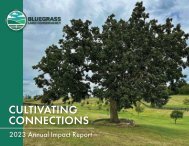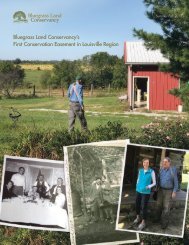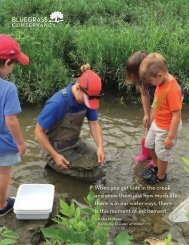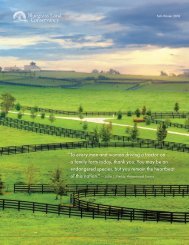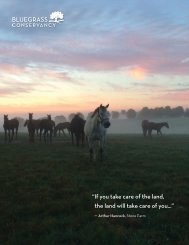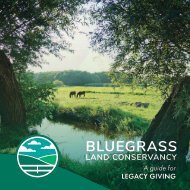BLC Conservation Easement Landowner Guide
A guide for Kentucky landowners: - What is a Conservation Easement? - Financial Benefits of Conservation Easements - About Land Trusts - Frequently Asked Questions - Landowner Stories
A guide for Kentucky landowners:
- What is a Conservation Easement?
- Financial Benefits of Conservation Easements
- About Land Trusts
- Frequently Asked Questions
- Landowner Stories
Create successful ePaper yourself
Turn your PDF publications into a flip-book with our unique Google optimized e-Paper software.
PART 1: WHAT IS A CONSERVATION EASEMENT?<br />
A<br />
conservation easement is a written, legal agreement between a property<br />
owner and a “holder” of the conservation easement, under which a<br />
landowner voluntarily restricts certain uses of the property in order to<br />
protect its natural, productive, or cultural features. The holder of the conservation<br />
easement must be a governmental entity or a qualified conservation<br />
organization (land trust, such as Bluegrass Land Conservancy “<strong>BLC</strong>”). The<br />
landowner conveys the easement to the holder, similar to the conveyance of<br />
a deed, and the easement is recorded in land and title records at the county<br />
courthouse. The landowner retains legal title to the property and determines the<br />
types of land uses to continue, as well as those to restrict.<br />
As part of the arrangement, the landowner grants the holder of the conservation<br />
easement the right to periodically assess the condition of the property to ensure<br />
that it is being maintained according to the terms of the legal agreement. A<br />
landowner who grants a conservation easement retains ownership of the land,<br />
while also agreeing to abide by the terms of the conservation easement. Once<br />
in place, the conservation easement is legally binding on all future owners of<br />
the land.<br />
Many rights come with owning property, including the rights to manage<br />
resources, change use, develop minerals, subdivide, or develop. With a<br />
conservation easement, a landowner limits one or more of these rights. For<br />
example, a landowner donating a conservation easement could choose to limit<br />
the right to develop or subdivide a property, but keep the rights to build a house<br />
in a certain location, hunt on the land, raise cattle or other livestock, and/or<br />
grow crops. The landowner continues to use the property in keeping with the<br />
conservation values set forth in the easement.<br />
<strong>Conservation</strong> easements are recognized for legal and tax purposes by the<br />
State of Kentucky (KRS 382.800) and the Internal Revenue Service (Internal<br />
Revenue Code, Section 170(h)). This guidebook seeks to answer general<br />
questions that a landowner might have about conservation easements.<br />
7




